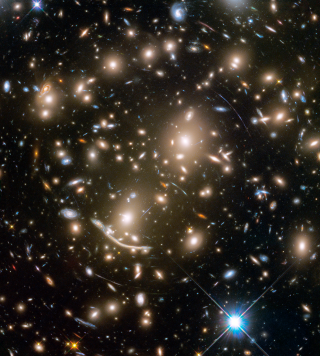Bibcode
Boschin, W.; Girardi, M.; Barrena, R.; Nonino, M.
Bibliographical reference
Astronomy and Astrophysics, Volume 540, id.A43
Advertised on:
4
2012
Journal
Citations
27
Refereed citations
27
Description
Context. The mechanisms producing the diffuse radio emission in galaxy
clusters, and in particular their connection with cluster mergers, are
still debated. Aims: We seek to explore the internal dynamics of
the cluster Abell 1758N, which has been shown to host a radio halo and
two relics, and is known to be a merging bimodal cluster.
Methods: Our analysis is mainly based on new redshift data for 137
galaxies acquired at the Telescopio Nazionale Galileo, only four of
which have redshifts previously listed in the literature. We also used
photometric data from the Sloan Digital Sky Survey and from the
Canada-France-Hawaii Telescope archive. We combined galaxy velocities
and positions to select 92 cluster galaxies and analyzed the internal
cluster dynamics. Results: We estimate a cluster redshift of
⟨z⟩ = 0.2782 and quite a high line-of-sight (LOS) velocity
dispersion σV ~ 1300 km s-1. Our 2D analysis
confirms the presence of a bimodal structure along the NW-SE direction.
We add several pieces of information to the previous merging scenario:
the two subclusters (here A1758N(NW) and A1758N(SE)) cannot be separated
in the velocity analyses and we deduce a small LOS velocity difference
(ΔVrf,LOS ≲ 300 km s-1 in the cluster
rest-frame). The velocity information successfully shows that A1758N is
surrounded by two small groups and active galaxies infalling onto, or
escaping from, the cluster. Removing the two groups, we estimate
σV,NW ~ 1000 km s-1 and
σV,SE ~ 800 km s-1 for A1758N(NW) and
A1758N(SE), respectively. We find that Abell 1758N is a very massive
cluster with a range of M = 2-3 × 1015
h70-1 M&sun;, depending on the adopted
model. Conclusions: As expected for clusters that host powerful,
extended, diffuse radio emissions, Abell 1758N is a major cluster merger
just forming a massive system.
Related projects

Galaxy Evolution in Clusters of Galaxies
Galaxies in the universe can be located in different environments, some of them are isolated or in low density regions and they are usually called field galaxies. The others can be located in galaxy associations, going from loose groups to clusters or even superclusters of galaxies. One of the foremost challenges of the modern Astrophysics is to
Jairo
Méndez Abreu

Cosmology with Large Scale Structure Probes
The Cosmic Microwave Background (CMB) contains the statistical information about the early seeds of the structure formation in our Universe. Its natural counterpart in the local universe is the distribution of galaxies that arises as a result of gravitational growth of those primordial and small density fluctuations. The characterization of the
FRANCISCO SHU
KITAURA JOYANES